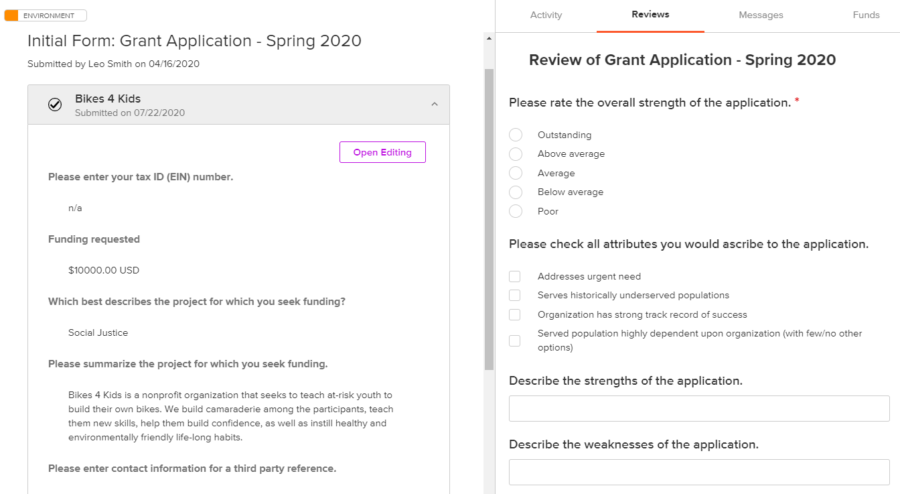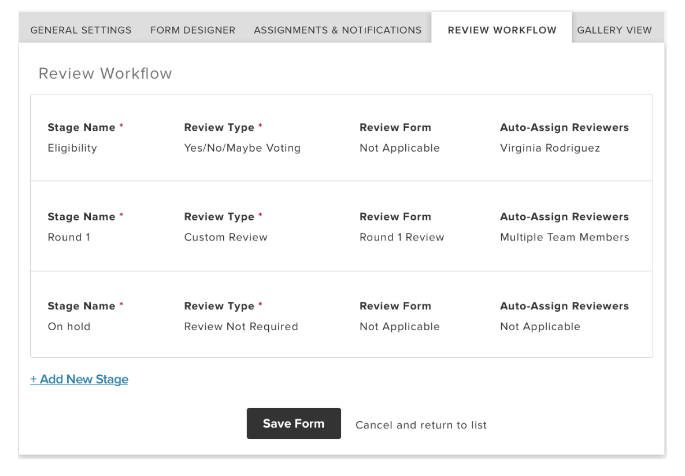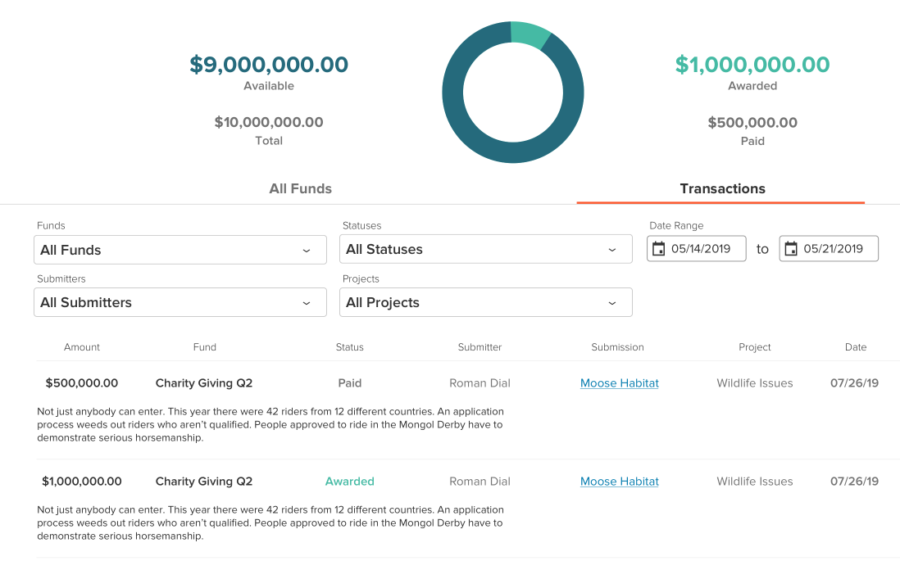Grant Management: What It Is and How to Do It
In this guide to grant management, you’ll learn everything you need to know about the grant management process.

Last Updated May 27, 2025
A guide to grant management for foundations and companies
The full grant management lifecycle—from pre-award planning to final reporting—can be daunting at first. Especially for a small organization or team, or someone just getting started on a new program.
But with the right tools and process in place, you can run an efficient program that achieves your mission and maintains your sanity.
As a developer of leading grant management software for grantmakers, Submittable works with thousands of grantmakers every day. This gives us a front row seat to grantmakers’ priorities, frustrations, and–best of all–the creative ideas and tools that help them achieve their mission.
Based on these insights, we’ve put together this guide. We’ll define key terms and points in the grant management process and suggest best practices and technology you can use now to achieve your goals.
What is grant management?
First, a clarifying note: The term “grant management” can also be used in relation to grant seekers who are writing proposals and reports, and then ensuring grant requirements are met as their organization spends grant funds.
But for the purpose of this guide, we’re focusing on grant management from the perspective of grantmakers: those who distribute grants and award funds.
For grantmakers, grant management encompasses the processes and administrative work that happen throughout the grant lifecycle. This includes setting up the grant, reviewing applications, selecting worthy recipients, disbursing grant funds, and ensuring those funds are put to good use.
Want to speed up your grant management process?
Submittable simplifies even robust grant review processes to save you time.
What is the role of a grant manager?
A grant manager—also sometimes referred to as a grant administrator or award manager—is generally the person responsible for ensuring a grant is awarded and implemented effectively.
This role creates and monitors application and review processes, provides initial and ongoing communication with applicants, and ensures consistent grant processing, tracking, and compliance.
The grant management process for grantmakers
Now that we’ve covered some of the foundational “what” questions, let’s dig into the “how.”
Effective grant management is important throughout the entire lifecycle of a grant, which can be broken into three stages: pre-award, award, and post-award.
We’ll cover each of the three stages, and the must-do activities in each of them—regardless of organization or grant type.
I. Pre-award stage
The pre-award stage involves everything that happens before the grant recipient is chosen, including the planning, application, and review processes. (It’s also our favorite stage because it’s where we get to help grantmakers the most.)
Key pre-award stage to-dos:
Develop your guidelines and implementation plans.
Collect applications.
Conduct a review process.
1. Develop your guidelines and implementation plans
Like any foundational step, this one is critical to setting your overall program up for success.
The better you can define who will receive grants and how, the clearer and easier things will be for everyone involved. It helps make sure your grant money is put to use more quickly and effectively.
Before anything is announced, gather your key stakeholders and discuss:
What is the funding source for the grant and type of grant offered (e.g. matching funds, direct grants, etc.)?
What is the end goal? What are you helping the grantee achieve?
Who will be able to apply, and what criteria and process will you use to select the recipient?
What are the key deadlines involved in your process?
What will you require of the grant recipient, and how will the organization report to you?
Your goal is to create crystal clear guidelines for yourself and grantees, and to nail down a complete implementation plan.
Remember: These guidelines and plans shape the quality of your applicants as well as your eventual decision-making process. Getting this part right saves you loads of time later.

Guidelines should be public for applicants at the top of your application portal. This reduces applicant questions and creates confidence and clarity around your process.
We encourage grantmakers who partner with us to spell out their guidelines and grantmaking philosophy publicly at the top of their Submittable portal. It’s also good practice to specify areas they will or won’t consider funding.
Being transparent about your guidelines and approach builds confidence in your organization and process, informs the broader community on your mission and principles, and saves you and applicants time.
2. Collect applications
First, if you haven’t already, please release yourself from the logistical nightmare of paper applications and applications submitted over email.
Creating an online grant application form makes things easier on applicants, expands your reach, and–when connected to a powerful grant management platform like Submittable–saves time for your staff when collecting applications, review applications, and subsequent reporting.
There are five key steps to creating an effective grant application form:
Use your guidelines to identify exactly what information you need in your application to determine eligibility and best fit.
Your application should collect all vital information, but nothing more; you don’t want to overwhelm applicants with unnecessary work. If you do this correctly, you’ll set your reviewers up for success and make later reporting requirements easier.
We think the following features are key to building an online application experience that creates a an efficient, effective process:
Flexible form builder. Look for a simple, drag-and-drop form builder where your staff–no matter their technical background–can easily build and edit your application.
Eligibility quizzes. Eligibility quizzes pre-screen applicants and save you (and applicants) from wasting time on applications that aren’t a good fit.
Advanced form logic creates different paths based on applicant answers, to keep forms relevant and concise.
With Submittable, you can build eligibility questions into your application form to save time using form logic or eligibility screening.
File uploads. Being able to accept different file types on your form means applicants can be more creative with their applications, including photos, video, tables and more.
Branded application portals. With Submittable, you can create branded, customized portals to give your grant application platform the same look and feel as the rest of your materials. You’ll make a polished, professional impression lets grant applicants know they’re in the right place.
Accepting payments. A system that accepts fees as part of the form also lets you streamline any payment collection.
Once you’ve set up your application, it’s time to announce your new grant program. You’ll need to figure how you’re going to promote your grant and get qualified people to apply. Consider marketing partnerships and reaching out to people and organizations directly.
3. Conduct a review process
Reviewing grant proposals can be the most exciting part of the pre-award process. But it can also be the most daunting and time-consuming, depending on the size of your review team.
By following these steps, you can run a smooth review process that surfaces the best-fit applicants to receive your funds.
Build a detailed review rubric to evaluate grants. A comprehensive rubric helps reviewers stay consistent, minimizes personal bias, and provides a useful resource to answer questions.

Having review rubrics and criteria side-to-side with applications in the Submittable platform keeps reviewers more focused and consistent as they review grant proposals.
Make good assignments. Recruit a qualified review team and have multiple readers or teams on each application to ensure all receive fair consideration. Breaking review into multiple rounds with deadlines and checkpoints along the way can reduce reviewer fatigue while keeping the process moving forward.

Easily set up a multi-stage process in Submittable. Each stage can be auto-assigned to the right team members and incorporate the style of review required at that point in your process.
Use a numerical strategy to find a winner. Score applications with a ranking system or a point system defined by your rubric. If an awardee isn’t immediately evident, it might be helpful to hold a meeting where reviewers discuss top contenders and their merits.
II. Award stage
The award stage is generally the shortest of the three phases. It’s where the grantmaker awards the grant, works with the awardee on a final agreement, and awards funds.
Key award stage to-dos:
Notify successful and unsuccessful applicants.
Finalize legal agreements.
Award funds.
During the award stage, the grantor notifies all applicants of their decision. Ideally, your grant management system lets you decline applications with bulk actions and customizable email templates to save you time.
The funder then drafts an agreement that spells out the terms of the grant. The recipient and grantor both sign the agreement, and the funds are disbursed to the recipient.
This might seem fairly straightforward for grants with a single recipient, but managing awards for a larger grant program can become overwhelming without a strong grant management system in place.
Look for a system with built-in funds tracking to stay on top of your budget and make sure you’re not overextending your organization.

https://youtu.be/aB\_JKPz\_iCk
III. Post-award stage
After the grant agreement has been signed and the funds have been disbursed, the post-award stage begins.
During this stage, the grantor and recipient work to ensure any expectations or requirements outlined in the agreement are being met. This stage includes the implementation, monitoring, and closeout of the grant program.
Key post-award to-dos:
Provide support and oversight.
Report on results.
Close out the grant.
Consider, how will your grant recipients report on their progress?
As the grantor, you may require the recipient to send you periodic reports about how the funds are being used and what is being accomplished. You can also set up an auditing program with on-site visits and in-person interviews or presentations.
Getting updates on how your grant money is being used can be crucial to funders, for meeting federal requirements, or making case studies to communicate your organization’s impact.
In Submittable, grantmakers often build additional online forms to collect follow up information and project updates.
Other grant reporting best practices include forging partnerships, structuring the report for learning, and seeking feedback from applicants.
The post-award period is also a crucial time to reflect and report on your own internal process.
What worked well? What didn’t?
Did your organization hit goals for efficiency, applicant numbers, diversity and more?
What rules and regulations should you revisit or add?
Digging into the data and analyzing the outcomes is the first step in understanding past results to inform future action.
Visualize your impact and measure collaborative results with Submittable’s Advanced Reporting.
Upon completing all the closeout requirements, including a review of the final financial reports and results from the awardee, the grant lifecycle comes to an end.
—
There’s a lot involved in the grant management process, but the right grant management software can make it easier to handle–and produce more-impactful results.
We’d love to help. To learn more about how Submittable can simplify your grantmaking process, including creating and hosting your grant application form, watch our demo video.

Keriann Strickland is the Chief Marketing Officer at Submittable where she leads its marketing and sales development teams. Happiest near mountains, she works from our Missoula, Montana office and has been with the company since 2018.






